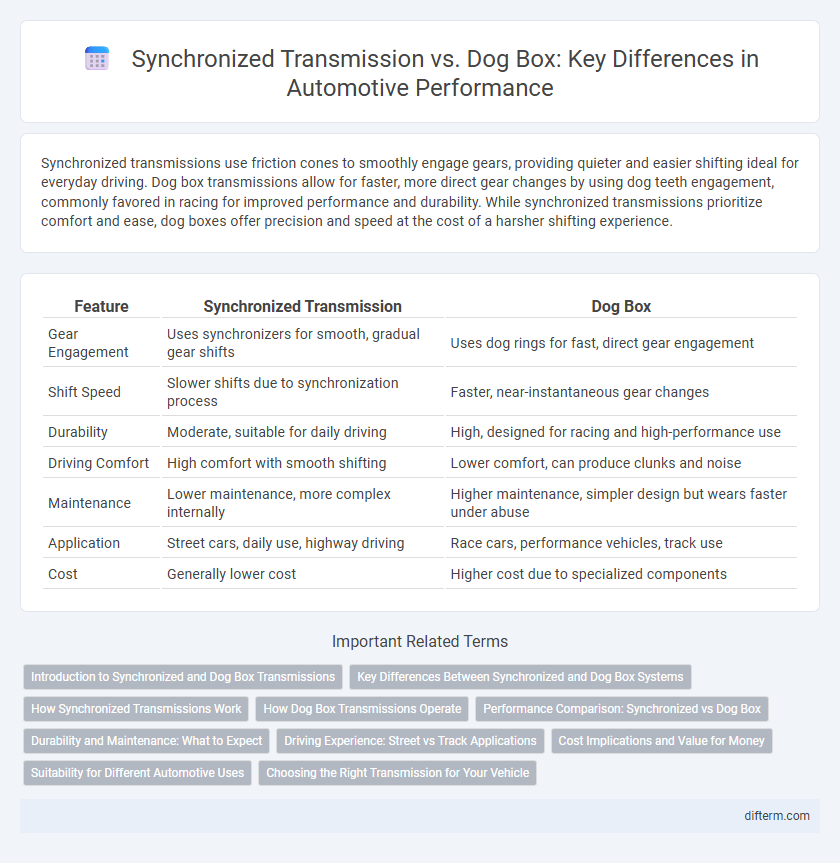Synchronized transmissions use friction cones to smoothly engage gears, providing quieter and easier shifting ideal for everyday driving. Dog box transmissions allow for faster, more direct gear changes by using dog teeth engagement, commonly favored in racing for improved performance and durability. While synchronized transmissions prioritize comfort and ease, dog boxes offer precision and speed at the cost of a harsher shifting experience.
Table of Comparison
| Feature | Synchronized Transmission | Dog Box |
|---|---|---|
| Gear Engagement | Uses synchronizers for smooth, gradual gear shifts | Uses dog rings for fast, direct gear engagement |
| Shift Speed | Slower shifts due to synchronization process | Faster, near-instantaneous gear changes |
| Durability | Moderate, suitable for daily driving | High, designed for racing and high-performance use |
| Driving Comfort | High comfort with smooth shifting | Lower comfort, can produce clunks and noise |
| Maintenance | Lower maintenance, more complex internally | Higher maintenance, simpler design but wears faster under abuse |
| Application | Street cars, daily use, highway driving | Race cars, performance vehicles, track use |
| Cost | Generally lower cost | Higher cost due to specialized components |
Introduction to Synchronized and Dog Box Transmissions
Synchronized transmissions use synchromesh mechanisms to match gear speeds for smooth, grind-free shifting, making them ideal for everyday driving and passenger vehicles. Dog box transmissions employ dog rings that engage gears directly without synchromesh, enabling faster and more precise gear changes preferred in racing and high-performance automotive applications. The key difference lies in shifting speed and engagement feel, with synchronized boxes prioritizing comfort and dog boxes emphasizing performance and durability.
Key Differences Between Synchronized and Dog Box Systems
Synchronized transmissions use friction-based synchros to match gear speeds for smooth and quiet shifting, ideal for everyday driving and OEM vehicles. Dog box systems utilize dog rings that engage gears instantly without synchromesh, offering faster, more durable shifts suited for racing and high-performance applications. Key differences include shift speed, durability, maintenance complexity, and drivability, with dog boxes providing aggressive shifting at the cost of increased noise and wear compared to synchronized setups.
How Synchronized Transmissions Work
Synchronized transmissions use synchronizer rings to match the speeds of gears before engagement, ensuring smooth and quiet shifting without gear clash. These synchronizers employ friction to equalize gear and shaft speeds, allowing seamless gear changes ideal for everyday driving. Compared to dog boxes, synchronized transmissions prioritize ease of use and durability over the rapid, direct engagement favored in racing applications.
How Dog Box Transmissions Operate
Dog box transmissions operate using mechanical engagement teeth that instantly lock gears together without the need for synchronizers, enabling faster and more direct gear shifts suitable for racing. The absence of synchronizers reduces shift times and drivetrain shock, but requires precise timing and driver skill to avoid gear clash. This design provides a robust and efficient power transfer, enhancing vehicle performance in high-stress automotive applications.
Performance Comparison: Synchronized vs Dog Box
Synchronized transmissions offer smoother gear shifts by using friction cones to match gear speeds, enhancing drivability in everyday automotive use. Dog box transmissions enable faster, more precise shifts via dog teeth engagement, minimizing shift times and power loss, which is ideal for high-performance racing applications. Performance analysis shows dog boxes outperform synchronized gearboxes in shift speed and durability under extreme driving conditions, though they require more skill to operate effectively.
Durability and Maintenance: What to Expect
Synchronized transmissions offer smoother gear shifts with synchromesh technology, reducing wear on gears and requiring less frequent maintenance, making them durable for daily driving. Dog box transmissions provide quicker shifts with less movement but experience higher wear on dog teeth, demanding more frequent inspections and potential component replacements. Choosing between the two depends on balancing maintenance intervals with the desired shift performance and durability in high-stress driving conditions.
Driving Experience: Street vs Track Applications
Synchronized transmissions offer smooth gear shifts and ease of use ideal for everyday street driving, reducing driver fatigue and enhancing comfort. Dog box transmissions provide rapid, precise gear changes with minimal interruption to power delivery, catering to high-performance track environments where speed and responsiveness are critical. The choice impacts driving experience significantly, with synchronized gearboxes favoring refinement and dog boxes prioritizing aggressive, race-oriented shifting dynamics.
Cost Implications and Value for Money
Synchronized transmissions typically come with higher manufacturing and maintenance costs due to their complexity and the need for friction materials like synchro rings, making them more expensive upfront and over time. Dog box gearboxes, often used in motorsport applications, offer a more cost-effective solution with simpler designs and fewer wearable parts, reducing long-term expenses despite a higher initial investment. For daily driving, synchronized transmissions provide smoother shifting and better value, while dog boxes maximize performance at a competitive cost, appealing to enthusiasts willing to accept rougher gear changes.
Suitability for Different Automotive Uses
Synchronized transmissions offer smooth shifting and are ideal for daily driving and passenger vehicles due to their ease of use and comfort. Dog box transmissions provide faster, more precise gear changes with minimal shift lag, making them better suited for racing and high-performance applications where speed and durability are critical. Choosing between the two depends on the balance of drivability and responsiveness required for specific automotive uses.
Choosing the Right Transmission for Your Vehicle
Synchronized transmissions offer smoother shifting with built-in synchronizers that match gear speeds, ideal for daily driving and extended vehicle longevity. Dog box transmissions provide faster, more direct gear engagement with reduced shift times, often preferred in motorsports and high-performance applications. Selecting the right transmission depends on balancing driving style, vehicle use, and desired shift precision.
synchronized transmission vs dog box Infographic

 difterm.com
difterm.com